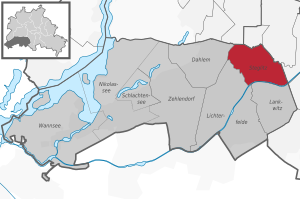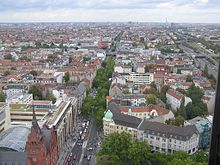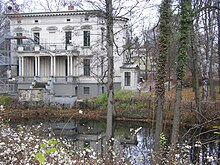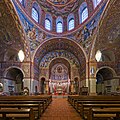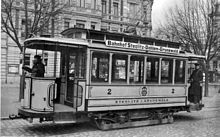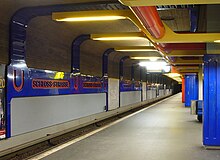Berlin-Steglitz
|
Steglitz district of Berlin |
|
|---|---|
| Coordinates | 52 ° 27 '28 " N , 13 ° 19' 23" E |
| surface | 6.79 km² |
| Residents | 75,803 (Dec. 31, 2019) |
| Population density | 11,164 inhabitants / km² |
| Incorporation | Oct. 1, 1920 |
| Postcodes | 12157, 12161, 12163, 12165, 12167, 12169 |
| District number | 0601 |
| structure | |
| Administrative district | Steglitz-Zehlendorf |
| Locations | |
Steglitz is a Berlin district in the sixth administrative district of Steglitz-Zehlendorf , which goes back to the historic Brandenburg village of Steglitz (until 1920: district of Teltow ).
location
Steglitz is located in the southwest of Berlin, at the transition between the densely built-up inner city districts and the suburban villa and residential suburbs. Steglitz is traditionally bourgeois , numerous residential areas emerged in the area as villa colony during the industrial era , and to this day the usual socio-geographical indicators are above the Berlin average.
The Steglitzer Schloßstraße forms the center of the district. It is the second largest shopping street in Berlin and therefore the most important central location in the south of Berlin. Architectural features there are the beer brush , the Steglitzer roundabout , the Steglitz town hall , the Steglitz manor , the adjoining Schlosspark Theater and the Schwartzsche Villa gallery , which is postally assigned to Grunewaldstraße .
Steglitz is located in the geological plateau landscape of Teltow on the ridge of the Rauhen Berge , which is only partially preserved today. The highest point of Steglitz is the Fichtenberg 68 m above sea level. NN . The Bäke and the Teltow Canal flow through the district .
Starting from the south, the district of Steglitz borders the neighboring districts of Lankwitz , Lichterfelde and Dahlem , in the north to the district of Wilmersdorf of the Charlottenburg-Wilmersdorf district and the Friedenau of the Tempelhof-Schöneberg district . The Bismarckviertel location forms the northeast border to the neighboring district of Schöneberg . The southern end of the village borders in a clockwise direction on the districts of Schöneberg and Tempelhof in the Tempelhof-Schöneberg district.
origin of the name
The place name Steglitz is of Slavic origin and means "place where there are goldfinches ". The place name is associated with the Altmark family of those von Stegelitz, to whom the founding of the village is ascribed. The two red bars in the coat of arms of the rural community and the district come from the family coat of arms of the von Stegelitz family.
history
middle Ages
The village of Steglitz was probably founded as a street village during the Ascanian land expansion during the first half of the 13th century (probably around 1230). In 1197 and 1248 a Henricus de Stegelitz is mentioned.
In the middle of the village there was probably a first wooden village church. Towards the end of the 13th century it was replaced by the Steglitz village church , a stone hall church with 72 seats.
The place itself is mentioned for the first time in 1375 in the land book of Charles IV , probably owned by the von Torgow zu Zossen . The usual information on hoof numbers is missing , etc. These are first known in 1450: 43 hooves, six of which are parish and one church hooves; an unusually high number in terms of ecclesiastical rights. In 1451 a jug is mentioned.
In 1517, a farm with ten free hooves is mentioned as the residence of the Speel (also from 'Spil' or 'Spiel'), who also have property in Dahlem.
Gutsbildung
The lord of the manor Christoph Erdmann von Spiel died as the last of his family in 1713. His tombstone is now on the outer north wall of the tower of St. Matthew's Church. The street village was deformed by the manor formation in the area of the Wrangelschlösschen . Its original core (Alt-Steglitz) was between the Steglitz town hall and the Steglitz manor . Until the 18th century, Steglitz remained a small village of only about a hundred inhabitants, who were only able to wrest a modest income from the barren soil and were practically completely dependent on the landlords, who only leased the land to them.
Steglitz benefited from its location on the old Reichsstraße 1 , today's Bundesstraße 1 , which - following a medieval trade route - originally stretched more than 1000 kilometers from Aachen via Berlin and Königsberg to the German- Lithuanian border and was the most important road connection in Germany. The section between Berlin and Potsdam was paved as the first country road in Prussia in 1792 .
From village to urban suburb
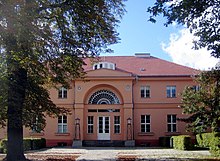
In 1801 or 1802, the Prussian Minister of State Carl Friedrich von Beyme acquired Gut and Dorf Stegelitz.
The Neu-Steglitz colony was established in the area of today's Albrechtstrasse and Breite Strasse. The Berlin silk merchant and manufacturer Johann Adolph Heese established a mulberry plantation with silkworms in the area of today's Bergstrasse in 1840 . Steglitz became the most important silk building center in Prussia.
The main line was built through Steglitz in 1838. Today the S-Bahn line S1 runs here . In 1839 Steglitz got a train station on the line, which was closed again in 1845 and reopened in 1864. In 1873 the Steglitz station received a representative station building, which was demolished in 1965 for the construction of the west bypass.
On March 28, 1870, Stegelitz and the Neu-Steglitz colony merged to form a rural community in the Teltow district. On this occasion, Stegelitz lost the second "e" in its name and was now called Steglitz .
The development of the suburbs of Berlin led to rapid population growth. This - as well as the establishment of extensive villa colonies in the neighboring villages of Lichterfelde-West and Dahlem - quickly led to an economic upturn. 1872/1873 saw the founding of the villa and cottage colony south end , but was not yet a part of Steglitz then. In 1875 the Steglitz cemetery was opened.
When the medieval village church became too small in the second half of the 19th century due to the increased number of parishioners, the much larger St. Matthew's Church was built and inaugurated in 1880. The old village church was demolished in 1881 because it was dilapidated.
The Berlin Prussian-Royal Facility for the Blind was relocated to the newly laid out Rothenburgstrasse in 1877 . Even today there are many facilities for the blind and visually impaired such as the Johann-August-Zeune-Schule .
In the east of Steglitz stood the sandy Rough Mountains . At the end of the 1880s a large sand pit was created because a lot of sand was needed as a building material. On the steep edge of the Steglitz sand pit, Otto Lilienthal made his first flight attempts in 1892 . In 1922, a backdrop was set up in the dunes for the film The Pharaoh's Wife, set in Egypt . Currently only remnants of the Rauhen Berge are left, recognizable above all in the Oehlertring area.
The Steglitz high school , which has existed since 1886, was the nucleus of the Wandervogel movement , which was founded in 1901 in the Ratskeller of the Steglitz town hall and which in turn represents the origin of the youth movement . Its chronicler Hans Blüher described Steglitz in 1913:
“One could have said of the master builders in Steglitz that they were talented silhouette cutters. If you walked from east to west in the evening and came from the Bäkeniederung and the other villa suburbs towards Steglitz, you saw the erect village shining in gold, the dome of the water tower at the top, the pointed towers of the Protestant shrine and the town hall a little further down then the solemn beauty of the Catholic Church, which stood so broad in the heroism of the diaspora ; [...] and there was no silhouette of a town in the whole wide area around Berlin that stood in such unforgettable forms as that of Steglitz. "
The Steglitz workshop , founded in 1900, is one of the most important germ cells of the German book art movement . At Fichtestrasse 59 (today: Lepsiusstrasse 23), one of the country's first classic advertising agencies with an attached print shop was established. The last of the three founders gave up the Steglitz site as early as 1906.
The tram of the community of Steglitz opened in 1905 between the train station and Grunewald. The Gleislobus Steglitz , one of the first trolleybuses in the world , operated in Steglitz from 1912 to 1914 .
After the population of Steglitz had grown to over 80,000, making Steglitz the largest rural community in Prussia , it was incorporated into the newly created Greater Berlin in 1920 . Mayor was from January 1, 1902 to April 1, 1921 the lawyer and local politician Karl Buhrow (1863-1939).
In 1927, two students were killed in the Steglitz school tragedy following a suicide pact.
During the Second World War , the villa colony Südende, at that time still a separate district, was almost completely destroyed. The area of the business center on Schloßstraße and the surrounding apartment blocks suffered much less damage.
Church struggle in National Socialism
Due to the size of its parish , Steglitz became a main stage of the church struggle between the Confessing Church and the faith movement of the German Christians , which began in June 1933 with the arrest of the pastor of the Markus parish, Otto Grossmann, by members of the SA directly from the pulpit. On the weekend 16./17. In March 1935 (the Prussian Confessional Church had planned to go public on Sunday, March 17, 1935, with a sharp pulpit denouncement against Nazi ideology) 715 pastors were imprisoned in Prussia ; In Berlin almost all active pastors were arrested. In September 1935, in response to the decree of the Nuremberg Race Laws, an Evangelical Synod of Confession met in the Markusgemeindesaal .
Steglitz synagogue
The Steglitz synagogue was built in 1897 on the rear part of the property owned by Moses Wolfenstein , who had founded the Steglitz Jewish community as early as 1878 . During the Reichspogromnacht from November 9th to 10th, 1938, it was devastated and looted by the National Socialists , but unlike many other synagogues, it was not set on fire because it was located in a densely built-up area. It was later used as a storage room and was initially intended for demolition in the 1980s, but then placed under monument protection in 1989 and then renovated . Today the former synagogue is a privately used building in a backyard that is not open to the public.
Mirror wall memorial
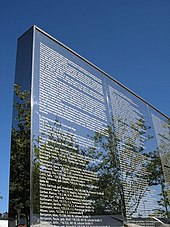
The dispute in the district about the erection of the Spiegelwand memorial on Hermann-Ehlers-Platz attracted international attention in the early 1990s . It was intended to commemorate the Steglitz synagogue of the Jewish community on Düppelstrasse and the Holocaust in Berlin. After a competition in 1992, the design by the artists Wolfgang Göschel and Joachim von Rosenberg (historical consultant Hans-Norbert Burkert) won with a highly polished chrome steel wall on which the names of Jewish citizens from Steglitz were engraved in 1723. The CDU was against the memorial because they thought the wall was oversized. She doubted that enough citizens had been involved in the competition process and led a public debate about the meaning of such a monument in a party-affiliated newspaper. Finally, in the vote in the District Assembly (BVV) on May 18, 1994 with the votes of the CDU, FDP and Republicans, the erection of the monument was rejected. Since state politicians called the process shameful and feared damage to Berlin's reputation, the then Building Senator Wolfgang Nagel ( SPD ) took the case and, contrary to the decision, had the memorial erected himself. On June 7, 1995, the mirror wall on Hermann-Ehlers-Platz was completed. Another negative media response at the inauguration was the refusal of the BVV majority to invite guests from Israel .
Steglitz district (1920–2001)

With the creation of Greater Berlin in 1920, Steglitz also became the name of the 12th administrative district of Berlin. This was formed from Steglitz, Groß-Lichterfelde , Lankwitz and the villa colony Südende, which had previously belonged to Mariendorf.
The former rural community of Steglitz now became part of the Steglitz district as a district of Steglitz. Other districts were Lichterfelde and Lankwitz . Until 1960, Südende was another district, after which it was incorporated into the district of Steglitz.
The merger of the district Steglitz with the Zehlendorf district took place in 2001 for the district of Steglitz-Zehlendorf . The district of Steglitz remained unchanged.
The coat of arms of the rural community and the Steglitz district was created in 1887 by Maximilian Gritzner . While the two red bars come from the family coat of arms of the Altmark family of Stegelitz, the black eagle's head is reminiscent of Kaiser Wilhelm I , through whom the coat of arms was awarded, refers to the proximity to the German capital and reminds us that Steglitz was long Prussian-royal Domain was.
Locations
Bismarck district

The Bismarckviertel in the northeast of the district, in the triangle between the main line , Thorwaldsenstrasse and Bergstrasse , was developed and built up from the turn of the 20th century. All street names are related to Chancellor Otto von Bismarck . During the Second World War , air raids by the Allies caused severe damage to the left and right of the main line when an attempt was made to interrupt the supply line to Berlin. The last bomb hole was closed in 2013. To the west of Bismarckstrasse , however, there was significantly less destruction, so that a large part of the historical building fabric was preserved here.
The quarter is now a middle-class residential area between City West , the Steglitz district center around Schloßstraße and the middle-class south-west of Berlin.
South end
Südende is a former villa colony in the southeast of the district, laid out after 1872 on former Mariendorfer farmland. Before the destruction, numerous artists and cultural workers lived here, such as the composer Arnold Schönberg , the painters George Grosz and Wassily Kandinsky, and the revolutionary Rosa Luxemburg .
During the Second World War , the villa colony was completely destroyed on the night of 23/24 August 1943 after the Royal Air Force lost its orientation during the bombing of Berlin under heavy flak fire and the bombs that were actually in the then government district around the New Reich Chancellery in Should hit middle , had dropped over south end. Only one villa at Grabertstrasse 4 survived the inferno ; the Steglitz-Zehlendorf music school is now located here.
After the war, the area lay fallow for many years and it wasn't until the 1960s that reconstruction began. In accordance with the needs of the time, the new buildings were mainly simple apartments for families, so that the character of the former villa colony has changed completely.
Residents
According to the last survey, 75,803 people currently live in the district.
In 2010 there were almost 72,000 people from the following areas of origin:
- Germany : 53,038 (73.8% of the population)
- Poland : 2,513 (3.5% of the population)
- Turkey : 2,495 (3.4% of the population)
- Former Yugoslavia : 1,781 (2.4% of the population)
- former Soviet Union : 1,612 (2.2% of the population)
- Arab states : 1,058 (1.4% of the population)
- East Asia ( People's Republic of China , South Korea etc.): 903 (1.2% of the population)
- Sub-Saharan Africa : 899 (1.2% of the population)
- Southeast Asia (mostly Thailand , Vietnam etc.): 857 (1.2% of the population)
- other areas of origin: 6,959 (9.7% of the population)
Churches
In 1880, the Protestant St. Matthew's Church was inaugurated as a replacement for the too small and dilapidated Steglitz village church. In 1900 the Catholic Rosary Basilica was built as a representative church for the Steglitz Catholics. The St. Mark's Church from 1912 burned down completely in the Second World War and was rebuilt in a simplified form in the 1950s. Between 1914 and 1919, the Evangelical St. Luke Church was also built east of the town center on Bergstrasse. It was initially in an almost undeveloped area, as the surrounding residential buildings were only built later in the 1920s. Other Protestant churches are the church in Südende , consecrated in 1958, and the Patmos Church from 1963. In 1951 the Catholic Church of St. John the Evangelist was consecrated. The Evangelical Free Church Baptist Church was built from 1952 to 1953.
economy
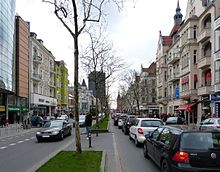
The central shopping center for the affluent south-western Berlin district of Steglitz-Zehlendorf is Steglitzer Schloßstraße , which is the largest retail location in Berlin with over 200,000 m² of retail space. In addition to the four large shopping centers Forum Steglitz , Das Schloss , Schloss-Straßen-Center and Boulevard Berlin , there are numerous shops there, some of which are multi-storey. There is also a wide range of dining options in the side streets.
traffic
railroad
There are three railway lines in the Steglitz area: the Berlin-Potsdamer Railway , which opened in 1838, and the New Wannsee Railway , which opened in 1891, share a common route and pass the center of the district not far from the old Berlin-Potsdamer Chaussee . The Steglitz train station, which opened for the first time in 1839 (since 1992: Steglitz town hall ), and the Feuerbachstrasse train station, which opened in 1933, are located within the district . The Anhalter Bahn, opened in 1841, and its suburban railway run through the southern end of the village , where the station of the same name is located. A fourth route, the Dresden Railway , runs along the district border with Tempelhof-Schöneberg.
The two suburban lines were electrified shortly after the beginning of the 20th century. While the electrical operation on the Wannsee Railway, which began in 1900, was only temporary and was discontinued in 1902, the electrical operation on the Anhalter Bahn lasted longer. Recorded in 1903, it was adapted to the Berlin S-Bahn system in 1929 . The Wannseebahn was then permanently electrified along with the neighboring long-distance railway using this system in 1933; the Dresden Railway followed in 1939.
While the Berlin-Potsdam long-distance railway was interrupted after the Second World War and therefore no longer has regular passenger traffic, the other routes mentioned are still in operation. On the Wannsee Railway, the S1 lines of the Berlin S-Bahn run between Wannsee and Oranienburg , and on the Anhalter Vorortbahn, the S25 line between Hennigsdorf and Teltow . The regional trains on the Anhalter Fernbahn stop in Lichterfelde Ost.
Transportation
In 1888 the first tram route to Steglitz went into operation. The connection built by the Berlin steam tram consortium led from the Zoo train station via Nollendorfplatz and Schöneberg to Schloßstraße and ended at the Schlosspark. About a year later, a depot for the railway was built not far from the end of the line, which was replaced in 1913 by a new building in a different location . In 1898 the company was transferred to the Westliche Berliner Vorortbahn , which electrified the line by May 18, 1899.
In the years that followed, the area between the palace gardens and the train station became the meeting point for several tram lines from different companies. In March 1895, the Groß-Lichterfelde - Lankwitz - Steglitz - Südende electric tram began operating two meter-gauge routes from the Steglitz station to the Groß-Lichterfelde station (today: Lichterfelde Ost) and another connection from the Steglitz station to the Südende station. Since the municipality wanted more routes to be built, but the local companies questioned their profitability, they began building their own tram from the station to the edge of the Grunewald in 1905 . In 1906 the Teltower Kreisbahnen took over the operations of the Lichterfeld tram, in 1909 that of the Steglitz municipal tram. In the years 1912–1914, further routes followed in the area of today's district, such as the extension of the municipal tram towards the Teltow Canal , the extension of the meter-gauge route from Südende to Mariendorf and that of the western Berlin suburban railway along the Unter den Eichen street . The Great Berlin tram operation in May 1914, more distance through the Bismarck area .
With the transfer of the tram operating rights to the Teltower Kreisbahnen they were granted the sole right to build and operate trams in the municipality. However, as Steglitz wanted the network to be expanded, the municipality decided to build a "trackless railway" - a trolleybus . The new means of transport went into operation on April 20, 1912 between the train station and Knausplatz in the north, but had to be stopped again when the First World War broke out.
Between 1919 and 1921 all tram operations were united under the roof of the Berlin tram . The meter-gauge routes were partially converted to standard gauge and otherwise shut down until 1930.
From 1935 trolleybuses again drove through Steglitz. The A 32 line, which was changed on May 2, 1935 , ran from Breitenbachplatz via Steglitz station to Marienfelde station . On April 23, 1942, the A 97 (from 1951: A 33) followed between Steglitz station and Mariendorf station. The latter took the same route as the tram route, which was closed in 1930.
After the decision to cease tram operations in West Berlin in 1953, the tramway in the district was shut down between 1959 and 1963. The two trolleybus lines were converted to buses in 1961 and 1965 respectively. Along with the changeover to bus operation, the construction of the underground line G (today: U9 ) in the direction of Steglitz and the construction of the western bypass began. In 1971 the subway reached Walther-Schreiber-Platz , and in 1974 it reached the town center at the town hall. The construction of the line to Lankwitz was not carried out, as was the construction of a second line on Schloßstraße, the F or U10 line .
The district is now served by the subway line U9 and numerous bus lines of the BVG in addition to the S-Bahn . The most important connections here are the Metrobus lines M48 ( Zehlendorf , Busseallee - S + U Alexanderplatz ), M82 ( Marienfelde , Waldsassener Straße - S + U Rathaus Steglitz) and M85 ( S Lichterfelde Süd - S + U Hauptbahnhof ). There are also the express bus routes X76 and X83, the day bus routes 170, 176, 181, 184, 186, 187, 188, 282, 283, 284, 285 and 380 as well as the night bus routes N81, N84 and N88.
Bicycle traffic
The planned rapid cycle connection Teltow Canal Route will lead through Steglitz, among other places.
education

In Berlin-Steglitz there are four integrated secondary schools , four practical seminars, a language school , six elementary schools , three vocational schools , two technical colleges , two technical schools , four grammar schools , a special school , two vocational schools and an art school .
Embassies and diplomatic missions
- Embassy of the Kingdom of Thailand at 64 Lepsiusstrasse
- Embassy of the Republic of Chad at Lepsiusstrasse 114
Personalities
- (in chronological order)
- Emma Döltz (1866–1950), social democrat, journalist and writer
- Emil Bernhard Cohn (1881–1948), rabbi and author
- Botho Henning Elster (1894–1952), major general in World War II , who ordered the largest surrender on the Western Front in 1944
- Wolfgang Krause (1895–1970), linguist and university professor
- Walter Fritzsche (1895–1956), national soccer player
- Rudolf Braschwitz (1900–1974), detective and SS leader in the Reich Security Main Office
- Jürgen Kroymann (1911–1980), classical philologist
- Kurt Aland (1915–1994), Protestant theologian and professor for New Testament introductory studies and church history
- Helga Cazas (1920–2008), French author of German-Jewish descent and Nazi victim
- Maria Sebaldt (* 1930), actress
- Wolfgang Helbich (* 1935), historian and university professor
- Kasimir1441 (* 200?), German rapper
See also
- List of streets and squares in Berlin-Steglitz
- List of cultural monuments in Berlin-Steglitz
- List of stumbling blocks in Berlin-Steglitz
literature
- Christian Simon: Steglitz. Between idyll and metropolis . 2nd act. Edition. be.bra verlag, Berlin 2012, ISBN 978-3-8148-0191-9 .
- Christian Simon: Steglitz - a historical overview . Berlin 2014, Ed .: Gabriele Schuster, Heimatverein Steglitz.
Web links
- The chronicle of Steglitz and homepage. District Office Steglitz-Zehlendorf
- Local history of Steglitz Heimatverein Steglitz; and Steglitz Museum
References and comments
- ↑ The sales area was 137,000 m² in 2006, making Schloßstraße the second largest after City-West (223,000 m²) , which is included as a whole, and ahead of the also very extensive retail location Kottbusser Damm / Hermannplatz / Karl-Marx-Straße in Neukölln (106,000 m²) Berlin retail location. Senate Department for Urban Development IA: Report on the development of centers and retail trade and on the promotion of urban centers (PDF; 482 kB), 2007. Tab. 2 on p. 12.
- ↑ Reinhard E. Fischer : The place names of the states of Brandenburg and Berlin , Berlin 2005, p. 162. So also Brandenburgisches Namenbuch , part 3: The place names of the Teltow , Weimar 1972, p. 176. The bird name Stieglitz is a Slavic loan word in German .
- ^ Steglitz - Museum Steglitz. Retrieved on May 5, 2019 (German).
- ↑ a b c The Chronicle of Steglitz ( Memento from August 16, 2010 in the Internet Archive ) District Office Steglitz-Zehlendorf
- ↑ a b c d Steglitz in the course of history . ( Memento from November 8, 2010 in the Internet Archive ) District Office Steglitz-Zehlendorf
- ↑ Wandervogel. History of a youth movement. 3. Edition. Berlin-Tempelhof 1913, p. 6.
- ↑ Buhrowstrasse. In: Street name lexicon of the Luisenstädtischer Bildungsverein (near Kaupert )
- ↑ Hans-Rainer Sandvoß (1986): Resistance in Steglitz and Zehlendorf ( Memento of November 4, 2016 in the Internet Archive ), p. 27 (PDF; 63 MB)
- ^ History of the Markusgemeinde 1933–1945 on www.markus-gemeinde.de
- ↑ District Office Steglitz-Zehlendorf: "Spiegelwand" - memorial, former Synagogue House Wolfenstein ( Memento from November 15, 2010 in the Internet Archive )
- ↑ mass murder, debated in meters . In: Berliner Zeitung , May 14, 1994.
- ↑ Three years of quarreling and an alliance with the Republicans . In: Berliner Zeitung , June 7, 2000.
- ↑ statistik-berlin-brandenburg.de ( Memento of the original from May 13, 2016 in the Internet Archive ) Info: The archive link was inserted automatically and has not yet been checked. Please check the original and archive link according to the instructions and then remove this notice. (Link no longer available)
- ↑ a b Udo Dittfurth, Michael Braun: The electric Wannseebahn. Time travel with the Berlin S-Bahn through Schöneberg, Steglitz and Zehlendorf . GVE, Berlin 2004, ISBN 3-89218-085-7 , pp. 6-13 .
- ↑ Detlef Hoge: The Anhalter Bahn. In: stadtschnellbahn-berlin.de. September 27, 2008, accessed February 18, 2013 .
- ↑ Detlef Hoge: The Dresden Railway. In: stadtschnellbahn-berlin.de. October 1, 2008, accessed February 18, 2013 .
- ^ Author collective: Tram Archive 5. Berlin and the surrounding area . transpress, Berlin 1987, ISBN 3-344-00172-8 , pp. 96-100 .
- ^ Author collective: Tram Archive 5. Berlin and the surrounding area . transpress, Berlin 1987, ISBN 3-344-00172-8 , pp. 102-106 .
- ^ Heinz Jung, Wolfgang Kramer: 100 years of the electric tram. Electric tram Gr.-Lichterfelde 1881–1906 . In: Berliner Verkehrsblätter . Issue 4–5, 1981, pp. 67-82 .
- ↑ Uwe Kerl, Wolfgang Kramer: 100 years ago: The "Grunewaldbahn" . In: Berliner Verkehrsblätter . Issue 12, 2005, pp. 231-236 .
- ^ Author collective: Tram Archive 5. Berlin and the surrounding area . transpress, Berlin 1987, ISBN 3-344-00172-8 , pp. 159-161 .
- ^ Hansjörg F. Zureck: The tram in Zehlendorf (1905-1959) . In: Berliner Verkehrsblätter . Issue 11, 2009, p. 207-210 .
- ^ Heinz Jung, Wolfgang Kramer: Line chronicle of the Berlin tram 1902–1945 . In: Berliner Verkehrsblätter . Issue 1, 1969, p. 16-18 .
- ^ Johannes Wolf: The first trolleybus routes in Berlin . In: Verkehrsgeschichtliche Blätter . Issue 8, 1979, pp. 126-129 .
- ↑ Heinz Jung: 50 years ago: discontinuation of meter gauge lines . In: Berliner Verkehrsblätter . Volume 2, 1980, pp. 29-31 .
- ^ A b Heinz Jung, Wolfgang Kramer: The trolleybus in Berlin . In: Berliner Verkehrsblätter . Volume 3, 1965, pp. 27-32 .
- ↑ Sigurd Hilkenbach, Wolfgang Kramer: The trams in Berlin . alba, Düsseldorf 1994, ISBN 3-87094-351-3 , p. 78-79 .
- ^ Marcus Schomacker: Berlin's subway lines. U9 Rathaus Steglitz - Osloer Straße. (No longer available online.) In: Berliner Untergrundbahn. Archived from the original on July 25, 2013 ; Retrieved February 18, 2013 .
- ↑ Berlin schools: List of the selected schools. In: berlin.de. Senate Department for Education, Youth and Science Berlin, accessed on September 2, 2014 .
